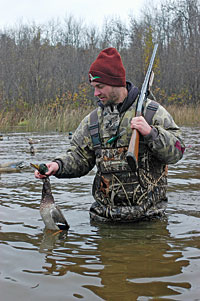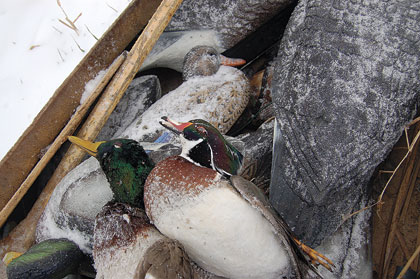September 24, 2010
By Joe Shead
Hunters might overlook small water, but ducks sure don't
By Joe Shead
 The author retrieves a greenhead from amongst the decoys during a small-water hunt in Wisconsin. |
Duck season had turned into a chess match, and the local mallards always had the first move.
Each morning, I watched helplessly from my concealed position as every single bird left the lake before legal shooting time, not to return until nightfall, when they swarmed back in to roost.
After a few days of this nonsense, I slept in before launching my canoe in a nearby creek. I slipped downstream deathly silent, hugging the inside of every turn as long as possible to screen my craft from alert eyes. My own eyes bored into every tuft of grass and beneath every overhanging branch for anything resembling a duck. Finally, as I came around a corner with a slack oxbow, I spotted them -- a half-dozen mallards casually feeding on duckweed. They apparently felt safe in this sequestered hideout, far from a hunter's everyday haunts.
As mallard eyes met mine and during that brief surprised moment between "oh no" and "let's get out of here," one word rang through my head: Checkmate.
Advertisement
Ditches and creeks are an important component of my duck hunting. From tiny creeks to irrigation ditches to small rivers, flowing waters offer a lot for ducks and duck hunters. These out-of-the-way haunts harbor ducks all season and often receive little hunting pressure. You can find birds there during shooting hours when adjacent lakes and marshes are birdless. Small creeks hold ducks during the lull between flights and when stagnant waters have frozen. They really are an all-season hunting destination.
FIND FOOD AND COVER
Not all creeks are created equal. Ideally, the creek should hold food and loafing cover. Ducks often visit creeks by day and roost on lakes or marshes by night. The shallow, narrow nature of creeks makes them ideal for tip-up feeders. The best creeks harbor duckweed, smartweed, wild rice or other ducky cuisine. If oak trees line the banks, wood ducks might be present to feed on fallen acorns. I've even encountered ducks over seemingly featureless, sandy bottom. I finally realized the ducks were eating snails.
Advertisement
Cover is another desirable creek feature. Creeks with grassy or brushy banks give ducks more sense of security from avian predators than bare-dirt ditches. Slack-water oxbows and side channels create perfect feeding and loafing areas, especially if they have logs or sandbars for loafing. However, ducks might sacrifice cover for food. I've killed woodies along bare-dirt ditches where just a dozen oaks were left standing. The birds couldn't resist those acorns, even though there was no grass or brush for cover.
If you can find a shallow creek that provides good cover and a ready food source, you'll almost certainly find ducks.
HUNTER APPEAL
One of the best features of creeks is they are often overlooked. Creeks aren't exactly made for the modern hunter's arsenal of a big boat, mud motor and a hefty decoy spread. Rather, you'll need a small duck skiff or canoe to hunt these little blue ribbons, and the shorter the better if the creek is narrow and windy.
Creeks are great places to escape crowded hunting areas, which are often riddled with competition for the best spots, sky busting and interference when finishing a flock.
Budget-minded hunters will also appreciate the limited gear list for creek hunting. But just because creek hunting requires only a minimal investment of a small boat, paddles and maybe a few decoys doesn't mean they necessarily result in low-quality hunts. Often, just the opposite is true.
Another big plus of hunting creeks is you can have shooting all day long. Hunting over decoys often means strictly morning and evening hunting, and when birds are pressured, sometimes just first light and last light. Not so on small, flowing waters.
If creeks are wide enough or have reasonably wide oxbows or back channels, birds might roost there. More often, however, ducks roost on adjacent marshes or lakes and fly to creeks to feed and loaf by day. To hunt these creeks, you not only will get daytime shooting, but you can sleep in to get it.
 Creeks often become prime duck hotspots when nearby marshes and lakes freeze. |
Although creeks hold birds all season long, in northern areas, they really excel when stagnant waters freeze. Then ducks must find open water or migrate. The flowing water of creeks keeps them from freezing quickly. Many times creeks and rivers become the only open water available, and birds concentrate in them, making for great hunting.
Cold-weather hunting is usually great for mallards, but you never know what you'll find in small creeks after lakes and ponds freeze. Sometimes you'll add geese and even divers such as buffleheads and ringnecks to the bag.
A QUIET RIDE
Creeks can be hunted a couple of ways. The standard method is jump shooting. If there's a long enough stretch of public land or private land you have permission to be on, you could walk the creek bank. Most jump shooting, however, is done by boat.
Put some thought into your jump-shooting boat. Get a craft suited to stealth hunting. Shy away from aluminum canoes. They are too noisy. They flex and creak when you shift your weight, clang when you hit your paddle on them and roar like a gong when you hit a rock. Plus, they easily lodge on top of underwater rocks.
Plastic or Royalex canoes, on the contrary, bounce up and over rocks and do so with a lot less noise. They are also much quieter if you shift your weight or bang a paddle.
If you do use an aluminum canoe, consider mounting pipe insulation along the gunwales and setting a rug in the bottom to reduce noise.
Your jump-shooting boat should also be maneuverable. Keeled canoes track straighter, making it hard to make tight turns. A shorter, keel-less canoe, say 14 feet or less, will handle much better than a longer, keeled model.
FINE POINTS OF JUMP SHOOTING
Experienced jump shooters have learned a few tricks that will help you bag birds. First, always hug the inside bend as long as possible so you can get closer to birds. Once you swing around the corner and reveal yourself, ducks will bust out. The first time or two you jump shoot a given creek, you'll often find birds right around a bend. Once ducks
have seen the game, however, they'll often sit on straightaways where it becomes much harder to sneak up on them.
Make subtle paddle strokes. A high paddle swing can reflect light like a mirror, announcing your presence. Paddle strokes should be light. Let the current do the work and just do the steering. Plan ahead and nose the canoe into position for each bend or obstacle so you can avoid hard strokes, which invariably cause loud, rushing water sounds that can give you away.
Stay low in the canoe or skiff. I prefer to kneel, which keeps me lower than sitting. If I need to, I can bend over and get really low when the cover is short. It also keeps a lower center of gravity and makes me less likely to tip if the boat hits a rock or when I'm trying to make an off-balance shot.
Always anticipate the hardest-possible shot. Unlike decoying, you won't see the birds coming, so you have to be ready for anything. If you're a right-handed shooter, the hardest shot is a bird flushing to your right. Pivot your hips slightly to the hardest side at all times so you'll be ready.
Check back bays and oxbows as you float past. Sometimes birds sitting in these slack areas off the main channel won't see you until you pass, then they will flush behind you. Peer into these areas and try to spot ducks early so you don't have to try a tough shot.
Keep your gun handy. Shot opportunities are often unexpected and sometimes fleeting. Have your gun in position for a fast shot. I like mine resting across the center yoke of my canoe on my right. I make sure the shotgun is not leaning against the side of the canoe so I can quickly get my hands around it. My dad likes his pointing behind him. He swings it forward and up for a shot. However you position it, make sure it is always accessible.
When ducks flush, you might not have much time to shoot. Drop your paddle and go for the gun. Placing the paddle in the boat wastes time. Obviously, make sure you always carry a spare paddle.
One last important jump-shooting consideration: how you'll do the float. If you have a partner, you can drive separately and leave a vehicle at the landing and takeout. If you're alone, leave your vehicle at the takeout and have someone drop you off. Paddling upstream against the current is no picnic.
SET A SPREAD
Few waterfowlers consider setting up decoys along creeks, but it can be fun and productive. Ducks become accustomed to feeding and loafing in specific spots along creeks and can often be ambushed in these places, even without using decoys. Using decoys, however, usually seals the deal and can attract fresh migrants that haven't yet learned the creek's best feeding areas. Decoying is also a good option if you can't arrange a shuttle or don't have time to do a full-length float.
The best way to learn the areas ducks frequent along creeks is to do a couple of floats. You'll quickly find which areas the birds use again and again.
Concealment can be an issue. I like to stash the boat and then hide in brush or grass. Learning which way the birds come from can help you hide the boat better. Check to make sure this option is legal and to learn who owns the creek bottom in your state.
Decoy spreads don't need to be big or elaborate. A half-dozen blocks is usually plenty. I like to place three or four decoys in the current, where they can swing back and forth on their tethers. Set a couple of sleepers on a sandbar, dump a feeder butt in the water and you have a simple yet realistic spread.
Like when hunting flooded timber, a duck call can announce your presence. Calls are especially useful when approaching birds have taken a fancy to another bend. You are trying to pull birds to a specific spot, so a few hail calls can clue birds to the party.
Shooting birds over decoys in narrow waters is exciting. Ducks are usually quite certain of exactly where they want to land, so they often come right in without circling. Shots are usually close -- sometimes too close. Hide in an area where you can see and shoot a ways. Ten-yard shots don't result in good table fare. Have some fun and consider shooting a 20 gauge. Decoying in creeks is also a great way to give youth hunters quality shot opportunities.
BIRD BENEFITS
Creeks are simply a joy to hunt. They receive hunting little pressure, provide daytime shooting and hold birds all season long. If you'd like to add more birds to your bag this season, duck the crowds and hit the skinny water.
Joe Shead can be found paddling for ducks in his home waters of Wisconsin.

